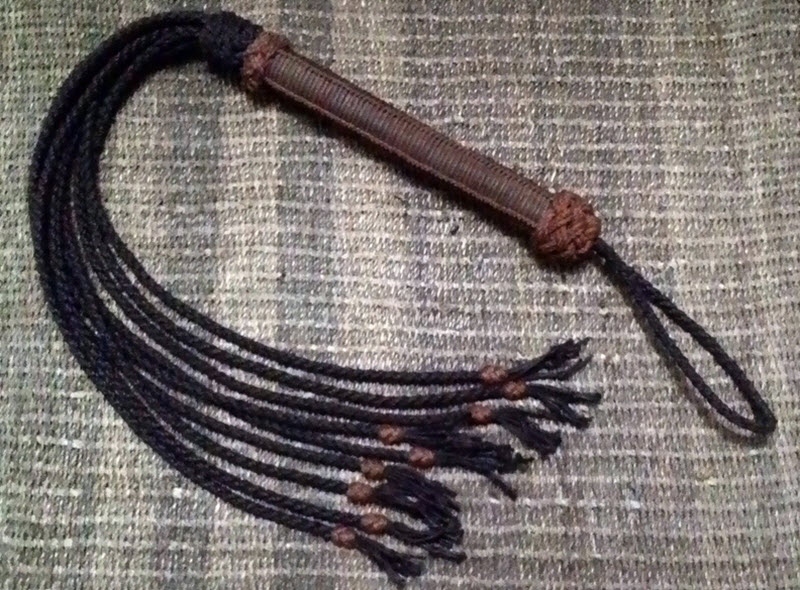Cat o’ nine tails
The cat o’ nine tails is a type of multi-tailed whip. Unlike many other whips, it’s was chiefly intended for use on humans and not to facilitate the handling of livestock or other animals.
The cat o’ nine tails has for instance been used to meter out physical punishments in the Royal Navy and Army of the United Kingdom, and for judicial punishments in the United Kingdom and many other parts of the British Empire.
In colloquial speech, the cat ‘o nine tails was often referred to simply as “the cat”. The term cat has also been used for other similar whips, e.g. whips with six tails.

Why is it called Cat o’ Nine Tails?
It’s called a Cat o’ Nine Tails (Cat of Nine Tails) because the whip has nine “tails”. It should also be noted that the whip can inflict parallel wounds, just like the claws of a cat’s paw.
The earliest usage of the term that we know of is from 1695, but the design itself is considerably odler.
A Cat o’ Nine Tails is not made from cat tails.
What does a Cat ‘o Nine Tails look like?
A Cat o’ Nine Tails is usually made by unravelling a rope into three smaller ropes, and then unravelling each of them, to give you a total of nine tails. The tails are then knotted.
Many different designs have existed throughout history, but approximately 75 cm is a very common length for a cat o’ nine tails. A commonly used material is cotton rope.
The Naval Cat (Captain’s Daughter)
Within the (British) Royal Navy, the Cat ‘o Nine Tails was commonly referred to as The Cat or The Captain’s Daughter. Formal floggings were ordered either by the ship’s captain or by court martial. Such floggings with the cat were carried out on deck in front of the rest of the crew.
The standard naval cat weighed about 13 ounces (370 grams). It consisted of a handle connected to nine thinner pieces of line. Along its lenght, each individual line was knotted several times. In films, we often get to see the Naval cat cut through the skin, but in reality it was much more likely to abrade the skin.
During the era of the Napoleonic Wars, the British Navy used a cat o’ nine tails where the handle was made of rope and covered in red baize cloth. The tails, which where around 2 feet long, were made of cord. A new cat was made for each flogging and kept in a red baize bag until it was time to use it. The person responsible for making the cat would be a bosun’s mate (bosun = boatswain, the senior most rate of deck department). A bosun’s mate (or several) would also be responsible for carrying out the lashing.
Punishment of Royal Navy boys
A lighter version of the whip was used summary punishment of Royal Navy boys. It was known as the Reduced Cat, Boy’s Cat, Boy’s Pussy or just Pussy. Instead of having nine tails, it had only six, and it was made form smooth whip cord.
If a boy was convicted by a court martial instead of being punished by order of the captain, the nine-tailed full-sized adult whip would be used instead of the Reduced Cat.
On training ships
On training ships where most of the crew were boys, cats weren’t used at all. Instead, the boys had their bare bottoms birched.
The British Army
The British Army employed a whip similar to the one used by the Navy, but much lighter in construction. The army whip consisted of strings attached to a drumstick, and the person responsible for carrying out the flogging was usually a drummer.
Compared to the naval cat, the army cat weighed less, the falls (tresses) were just 1/8th of an inch and the string used to make the cat was codline, a dense material similar to tarred string. A flogging with the army cat was much more likely to cut the skin than a flogging with the naval cat, since the army cat’s strings were thinner and denser.
Around 1870, the British Army stopped using floggings with the cat ‘o nine tails as punishment.
Australia’s penal colonies
In early colonial Australia, the cat o’ nine tails was used for floggings in the penal colonies.
Reports from Norfolk Island mentions a cat o’ nine tails made from nine leather thongs instead of cotton rope. Also, this fearsome cat o’ nine tails had a led weight attached to each tail to make the injuries even worse.
Canada
In Canada, use of the cat o’ nine tails as corporal punishment was abolished in 1881.
Prison usage in the United Kingdom
In 1951, the UK prisons for male inmates were ordered to use only officially approved cat o’ nine tails from the national stock kept at Wandsworth prison. At Wandsworth, the whips were thoroughly tested before being sent out to other prisons throughout the UK.
Modern day use in the Caribbean
Some former British colonies in the Caribbean have kept or reinstated flogging with the cat as a form of judicial corporal punishment.
Trinidad & Tobago never banned the use of the cat. The Corporal Punishment Act of 1953 stipulated that flogging was allowed if the convicted was male and over the age of 16. In the year 2000, the age limited was increased to 18 years.
Antigua and Barbuda reinstated flogging with the cat in 1990. Bahamas followed in suit the year after, but that law was short lived. Barbados reinstated flogging with the cat in 1993, but this law was soon declared unconstitutional by the Barbados Supreme Court.